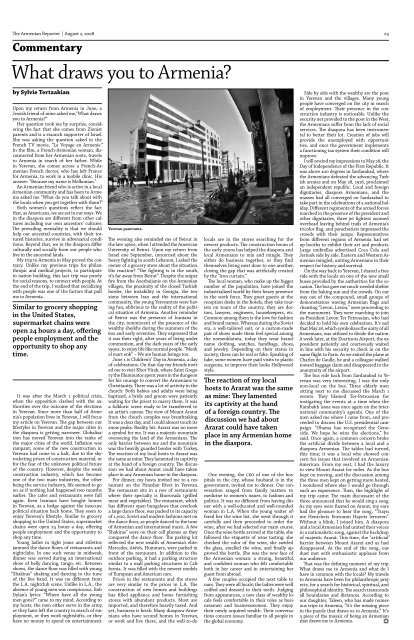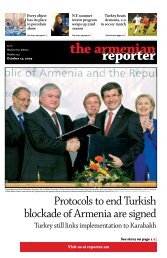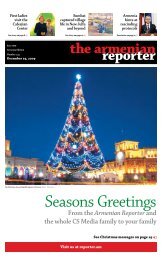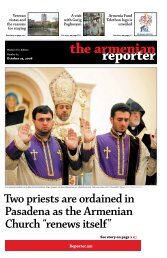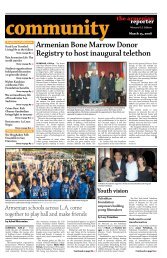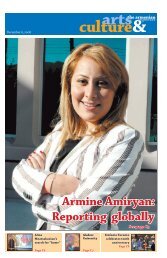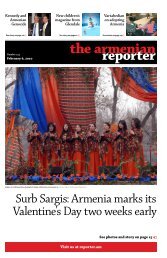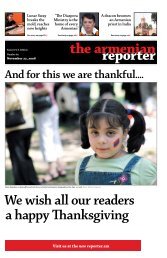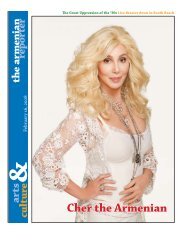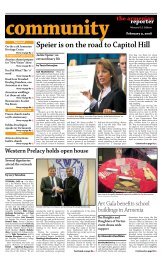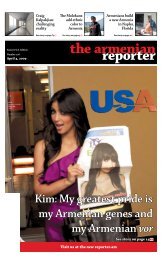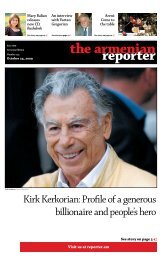Armenia's Olympic Team heads to Beijing with high hopes
Armenia's Olympic Team heads to Beijing with high hopes
Armenia's Olympic Team heads to Beijing with high hopes
- No tags were found...
You also want an ePaper? Increase the reach of your titles
YUMPU automatically turns print PDFs into web optimized ePapers that Google loves.
The Armenian Reporter | August 2, 2008 23CommentaryWhat draws you <strong>to</strong> Armenia?by Sylvie TertzakianUpon my return from Armenia in June, aJewish friend of mine asked me,“What drawsyou <strong>to</strong> Armenia?”Her question <strong>to</strong>ok me by surprise, consideringthe fact that she comes from Zionistparents and is a staunch supporter of Israel.She was asking the question asked in theFrench TV movie, “Le Voyage en Armenie.”In the film, a French-Armenian woman, disconnectedfrom her Armenian roots, travels<strong>to</strong> Armenia in search of her father. Whilein Yerevan, she comes across a French-ArmenianFrench doc<strong>to</strong>r, who has left Francefor Armenia, <strong>to</strong> work in a mobile clinic. Hisanswer: “Because my name is Melkonian.”An Armenian friend who is active in a localArmenian community and has been <strong>to</strong> Armeniaasked me “What do you talk about <strong>with</strong>the locals when you get <strong>to</strong>gether <strong>with</strong> them?”Both women’s questions reflect the factthat, as Americans, we are set in our ways. Wein the diaspora are different from other culturesincluding our own ances<strong>to</strong>rs’ cultures.The prevailing mentality is that we shouldhelp our ancestral countries, <strong>with</strong> their <strong>to</strong>rturedhis<strong>to</strong>ries, survive in adversarial conditions.Beyond that, we in the diaspora differculturally and socially from our people wholive in the ancestral lands.My trip <strong>to</strong> Armenia in May proved the contrary.Unlike my previous trips for philanthropicand medical projects, <strong>to</strong> participatein nation building, this last trip was purelyfor social reasons, <strong>to</strong> connect <strong>with</strong> people. Atthe end of the trip, I realized that socializing<strong>with</strong> people was one of the fac<strong>to</strong>rs that pullme <strong>to</strong> Armenia.Similar <strong>to</strong> grocery shoppingin the United States,supermarket chains wereopen 24 hours a day, offeringpeople employment and theopportunity <strong>to</strong> shop anytime.It was after the March 1 political crisis,when the opposition clashed <strong>with</strong> the authoritiesover the outcome of the electionsin Yerevan. Since more than half of Armenia’spopulation lives in Yerevan, I will focusmy article on Yerevan. The gap between ourlifestyles in Yerevan and the major cities inthe diaspora is getting narrower. Globalizationhas moved Yerevan in<strong>to</strong> the ranks ofthe major cities of the world. Inflation wasrampant; some of the new construction inYerevan had come <strong>to</strong> a halt, due <strong>to</strong> the skyrocketingprices of construction material, orfor the fear of the unknown political futureof the country. However, despite the weakconstruction industry, which has becomeone of the two main industries, the otherbeing the service industry, life seemed <strong>to</strong> goon as if nothing had happened two monthsearlier. The cafes and restaurants were fullagain. Even Iranians have bought homesin Yerevan, as a hedge against the insecurepolitical situation back home. They seem <strong>to</strong>enjoy Yerevan’s lifestyle. Similar <strong>to</strong> groceryshopping in the United States, supermarketchains were open 24 hours a day, offeringpeople employment and the opportunity <strong>to</strong>shop any time.Young ladies in tight jeans and stilet<strong>to</strong>sjammed the dance floors of restaurants andnightclubs. In one such venue in midweek,dinner was served during an internationalshow of belly dancing, tango, etc. Betweenshows, the dance floor was filled <strong>with</strong> young“Shakiras” shaking and dancing <strong>to</strong> the tuneof the live band. It was no different fromthe L.A. nightclub scene. Unlike in L.A., theabsence of young men was conspicuous. BobDylan’s lyrics: “Where have all the youngmen gone?” came <strong>to</strong> my mind. According <strong>to</strong>my hosts; the men either serve in the army,or they have left the country in search of employment,or they work nightshifts, or theyhave no money <strong>to</strong> spend on entertainment.Yerevan panorama.The evening also reminded me of Beirut inthe late 1960s, when I attended the AmericanUniversity of Beirut. Upon my return fromIsrael one September, concerned about theheavy fighting in south Lebanon, I asked theowner of a grocery s<strong>to</strong>re about the situation.His reaction? “The fighting is in the south,it’s far away from Beirut”. Despite the sniperfire from the Azerbaijanis on the Armenianvillages, the proximity of the closed Turkishborder, the instability in Georgia, the tensionsbetween Iran and the internationalcommunity, the young Yerevantsis were havingfun, oblivious <strong>to</strong> the reality of the politicalsituation of Armenia. Another reminderof Beirut was the presence of Iranians inthe city, reminiscent of the presence of thewealthy sheikhs during the summers of the60s and early seventies. They expressed thatit was their right, after years of living undercommunism, and the dark years of the early1990s, <strong>to</strong> enjoy life like normal people. “Menkel mart enk” – We are human beings <strong>to</strong>o.June 1 is Children’s’ Day in Armenia, a dayof celebrations. On that day my friends invitedme <strong>to</strong> visit Khor Virab, where Saint Gregorythe Illumina<strong>to</strong>r spent years in the dungeonfor his courage <strong>to</strong> convert the Armenians <strong>to</strong>Christianity. There was a lot of activity in thechurch: Both babies and adults were beingbaptized, a bride and groom were patientlywaiting for the priest <strong>to</strong> marry them. It wasa folkloric scene ready <strong>to</strong> be transferred <strong>to</strong>an artist’s canvas. The view of Mount Araratfrom the church complex was breathtaking.It was a clear day, and I could almost <strong>to</strong>uch itssnow peaks. Reality hit: Ararat was no morea symbol for me. It was a majestic mountainoverseeing the land of the Armenians. Theonly barrier between me and the mountainwas the heavily guarded border <strong>with</strong> Turkey.The reaction of my local hosts <strong>to</strong> Ararat wasthe same as mine: They lamented its captivityat the hand of a foreign country. The discussionwe had about Ararat could have takenplace in any Armenian home in the diaspora.For dinner, my hosts invited me <strong>to</strong> a restauran<strong>to</strong>n the Hrazdan River in Yerevan.The restaurant sits in a row of restaurantswhere their specialty is khorovadz (grilledmeat and vegetables). The restaurant, whichhas different open bungalows that overlooka large dance floor, was packed <strong>to</strong> its capacityof 1,000. Soviet and modern fashions met onthe dance floor, as people danced <strong>to</strong> the tuneof Armenian and international music. A few“Shakiras” were on their cell phones as theyconquered the dance floor. The parking lotreflected the new wealth of Armenia’s elite:Mercedes, BMWs, Hummers, were parked infront of the restaurant. In addition <strong>to</strong> theoutdoor parking, it had a parking structuresimilar <strong>to</strong> a mall parking structures in California.It was filled <strong>with</strong> the newest modelsof European and American cars.Prices in the restaurants and the s<strong>to</strong>resare very similar <strong>to</strong> the prices in L.A. Theconstruction of new homes and buildingshas filled appliance and home furnishings<strong>to</strong>res <strong>with</strong> abundant products. Most areimported, and therefore heavily taxed. Andyet, business is brisk: Many diaspora-Armenianswho have second homes in Yerevan,or work and live there, and the well-<strong>to</strong>-dolocals are in the s<strong>to</strong>res searching for thenewest products. The construction boom ofthe early 2000s has helped the diaspora andlocal Armenians <strong>to</strong> mix and mingle. Theyeither do business <strong>to</strong>gether, or they findthemselves living next door <strong>to</strong> one another,closing the gap that was artificially createdby the “iron curtain.”The local women, who make up the biggernumber of the population, have joined theindustrialized world by their heavy presencein the work force. They greet guests at thereception desks in the hotels, they take <strong>to</strong>uristson <strong>to</strong>urs of the country, they are doc<strong>to</strong>rs,lawyers, engineers, housekeepers, etc.Common among them is the love for fashionand brand names. Whereas during the Sovietera, a well-tailored suit, or a cus<strong>to</strong>m-madepair of shoes made them feel special amongthe nomenklatura, <strong>to</strong>day they wear brandnameclothing, watches, handbags, shoes,and jewelry. Depending on their status insociety, these can be real or fake. Speaking offake, some women have paid visits <strong>to</strong> plasticsurgeons, <strong>to</strong> improve their looks Hollywoodstyle.The reaction of my localhosts <strong>to</strong> Ararat was the sameas mine: They lamentedits captivity at the handof a foreign country. Thediscussion we had aboutArarat could have takenplace in any Armenian homein the diaspora.One evening, the CEO of one of the hospitalsin the city, whose husband is in thegovernment, invited me <strong>to</strong> dinner. Our conversationranged from family matters <strong>to</strong>medicine <strong>to</strong> women’s issues, <strong>to</strong> fashion andpolitics. It was no different from having dinner<strong>with</strong> a well-educated and well-roundedwoman in L.A. When the young waiter offeredher the wine list, she went through itcarefully and then proceeded <strong>to</strong> order thewine, after we had selected our main course.Once the wine bottle arrived at the table, shefollowed the etiquette of wine tasting: shechecked the color of the wine, she swirledthe glass, smelled the wine, and finally approvedthe bottle. She was the new face ofthe Armenian woman: a strong, beautiful,and confident woman who felt comfortableboth in her career and in entertaining herguest from abroad.A few couples occupied the next table <strong>to</strong>ours. They were all locals; the ladies were wellcoiffed and dressed <strong>to</strong> their teeth. Judgingfrom appearances, a new class of wealthy localsfeels comfortable in their roles as businessmenand businesswomen. They enjoytheir newly acquired wealth. Their conversationsconcern issues familiar <strong>to</strong> all people inthe global economy.Side by side <strong>with</strong> the wealthy are the poorin Yerevan and the villages. Many youngpeople have converged on the city in searchof employment. Their presence in the constructionindustry is noticeable. Unlike thesecurity net provided <strong>to</strong> the poor in the West,the Armenians suffer from the lack of socialservices. The diaspora has been instrumental<strong>to</strong> better their lot. Creation of jobs willprovide the unemployed <strong>with</strong> opportunities,and once the government implementsa functioning tax system their condition willimprove.I will rewind my impressions <strong>to</strong> May 28, theDay of Independence of the First Republic. Itwas above 100 degrees in Sardarabad, wherethe Armenians defeated the advancing Turkisharmies and on May 28, 1918, proclaimedan independent republic. Local and foreigndignitaries, diaspora Armenians, and themasses had all converged on Sardarabad <strong>to</strong>take part in the celebrations of a national holiday.Different regiments of the armed forcesmarched in the presence of the president andother dignitaries, three jet fighters zoomedoverhead leaving behind trails of Armenia’stricolor flag, and parachutists impressed thecrowds <strong>with</strong> their jumps. Representativesfrom different regions of Armenia had setup booths <strong>to</strong> exhibit their art and products.Large umbrellas advertised Coca Cola andJermuk side by side. Eastern and Western Armenianmingled, uniting Armenians in theirrespect for his<strong>to</strong>ry and survival.On the way back <strong>to</strong> Yerevan, I shared a freeride <strong>with</strong> the locals on one of the new smallbuses provided by the authorities for the occasion.The bus gave me much-needed shelterfrom the baking sun and the crowds. On ourway out of the compound, small groups ofdemonstra<strong>to</strong>rs waving Armenian flags andchanting “Levon, Levon,” were proceeding <strong>to</strong>the monument. They were marching <strong>to</strong> joinex-President Levon Ter Petrossian, who haddecided <strong>to</strong> hold his own celebration. It’s sadthat May 28, which symbolizes the unity of allArmenians, was utilized <strong>to</strong> divide the nation.A week later, at the Zvartnots Airport, the expresidentpatiently and courteously waitedin line <strong>with</strong> his security <strong>to</strong> check in on thesame flight <strong>to</strong> Paris. As we exited the plane atCharles de Gaulle, he and a colleague walked<strong>to</strong>ward baggage claim and disappeared in theanonymity of the airport.The bus ride back from Sardarabad <strong>to</strong> Yerevanwas very interesting. I was the onlynon-local on the bus. Three elderly mensitting next <strong>to</strong> me discussed the March 1events. They blamed Ter-Petrossian forinstigating the events at a time when theKarabakh issue was once again on the internationalcommunity’s agenda. One of themen asked me where I came from, and proceeded<strong>to</strong> discuss the U.S. presidential campaign.“Obama has recognized the Genocide.We hope he wins the elections,” hesaid. Once again, a common concern brokethe artificial divide between a local and adiaspora Armenian. The tables had turned,this time; it was a local who showed concernfor issues that involved an Armenian-American. From my seat, I had the luxury<strong>to</strong> view Mount Ararat for miles. As the buskept on moving, and the discussion amongthe three men kept on getting more heated,I wondered where else I would go throughsuch an experience. Then, the <strong>high</strong>light ofmy trip came: The main discussant of thethree announced that he would sing a song.As my eyes were fixated on Ararat, my earshad the pleasure <strong>to</strong> hear the song, “Tsaynme Hentchets Erzroumi Hayots lerneren”.Without a blink, I joined him. A diasporaand a local Armenian had united their voicesin a nationalistic song, against the backdropof majestic Ararat. This time, the “artificial”barrier between Mount Ararat and us haddisappeared. At the end of the song, ourduet met <strong>with</strong> enthusiastic applause fromour audience.That was the defining moment of my trip.What draws me <strong>to</strong> Armenia and what do Ihave in common <strong>with</strong> the locals? My travels<strong>to</strong> Armenia have been for philanthropic projects,for a search for his<strong>to</strong>rical, spiritual, andphilosophical identity. The search transcendsall boundaries and distances. According <strong>to</strong>our daughter, Taleen, who has made numeroustrips <strong>to</strong> Armenia, “It’s the missing piecein the puzzle that draws us <strong>to</strong> Armenia.” It’sa piece of the mosaic of being an Armenianthat draws me <strong>to</strong> Armenia.f


